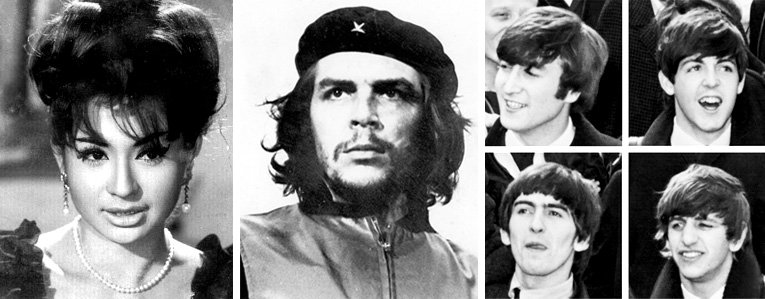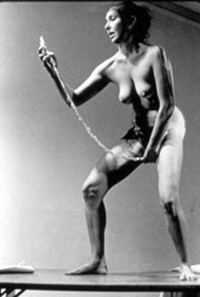The School of Arts and Aesthetics in Jawaharlal Nehru University (J.N.U.), Delhi, recently invoked the mysticism, iconography, and complexities of the period most popularly known as the “Swinging Sixties”. The two-day conference at the university, titled The Global Sixties and Its Cultural Afterlife, saw eminent intellectuals and academicians from all over the globe deliberate and debate the cultural, political, and artistic consequences of this seminal period in world history.
From an insight into the politics of the Aswan Dam and the work of Egyptian artists, to postcolonial perspectives of the European art cinema of the period, the histories of cities like Bombay, Naxalism, Hitchcock, the political precedents for jazz music, and even Pink Floyd; everything and anything related to the Sixties was mystified and de-mystified simultaneously.

Poster children: (From left to right) Helen, Che Guevara, The Beatles.
The Sixties have been a period of myth, celebration, and protestation. It is the period that has been marked in popular memory associated with rock music, the Beatles, New Wave films, the Vietnam War and the hippie culture, Warhol’s pop-art commodifying the popular iconography of America, the rise of the Oriental East as the seat of religious, spiritual, and transcendental meditation, etc. Though there may be a certain coherence across the globe over the popular imagery of the Sixties, the turbulence of the period was marked with geo-political and social consequences across Europe and America. The points of conflict arising in America and across the Pacific, in France had different political undertones. While the tempestuous time is marked in the U.S.A. as the counterculture in popular lingo, where truly profound changes occurred in the political, legal, and social structure of race relations in the nation, France was dealing with the end of its colonial empire and the rise of modernisation. The post-World War politics of the economy and the social strata in both the two countries have been expressed, portrayed and depicted across numerous forms of visual, literary, and oral manifestations.
This “period of counter-culture” has always been associated in popular memory with various forms of nostalgia, differing from region to region and people to people, and the political or social consequences of the developments of this decade still reverberate. It wouldn’t be an exaggeration to say that the concept behind this entire seminar was unique in its own way. Seeing posters of dancing diva Helen sharing the same space as the iconic revolutionary Che Guevara itself spoke out visually of the multi-faceted versatility that the period encapsulated.
Apart from the usual discussions that generate while engaging with the Sixties, such as rebellion, counter-culture, the Beatles, etc., it was refreshing to witness an engagement other than the Euro-centric approach to this period. Avinoam Shalem, from the Munich University, in a deeply riveting presentation talked on Gamal Abdel Nasser, the Great Dam of Aswan, and the surrealist artist Abdel Hadi al-Gazar, while Greg Booth, from the University of Auckland, spoke on The Hindi Film Song in a Global 1960s. While both these talks enthralled a full auditorium, it was also enlightening and fascinating to see the ripples of this period across the globe.
The one paper that truly mesmerised the audience was Ranjit Hoskote’s presentation on Bombay of the Sixties. Hoskote, a seasoned cultural theorist and poet, literally swept in a wave of nostalgic longing for that period when cosmopolitanism and modernism were the key words defining this emerging metropolis post-Independence. “All forms of retrospection are forms of repression”—with this sentence, he literally roused the “phantoms of desire” amongst the audience.
In Bernardo Bertolucci’s The Dreamers (an evocative film on the Student’s Revolution in Paris in 1968), one of the characters, a poet, reads out his most famous line: “A poem is a petition, a petition is a poem”. To paraphrase it in another way, a petition may be a poem, and a poem may be a petition, but neither a poem nor a petition is the revolution. This perhaps captures in essence how this period of intellectualism and rebellion that defined the last century should not be bottled. Rather, like the transcendence of the period, the spirit must waft out in the air for the future generations and progeny of the Flower Power-holders to understand what should or shouldn’t be done in the history of the world.








